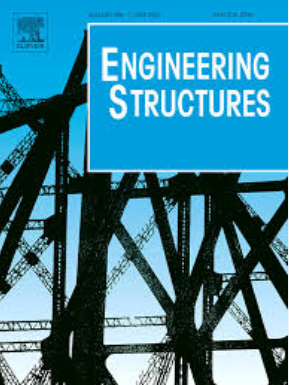Experimental investigation and numerical analysis on fire response of parallel-wire cable exposed to open-air fire
IF 5.6
1区 工程技术
Q1 ENGINEERING, CIVIL
引用次数: 0
Abstract
This paper presents experimental and numerical studies on fire behaviors of a parallel-wire cable subjected to an open-air fire and applied tension. A novel fire resistance test of cable was designed for observing mechanisms of fire propagation and structural deformation; subsequently, a numerical method is established for evaluating corresponding fire behaviors of the cable exposed to the pool fire. The experimental results showed that, a coupling fire of pool fire and cable surface fire could occur; the sheath sequentially provided the insulation effect in the pre-ablation and combustion-supporting effect in the post-ablation; thermal conductivities in the radial and axial directions of the wire bundle differed; and deformation of the cable was characterized by three stages. The numerical results illustrate that, the established method can successfully reproduce the fire behaviors from the fire’s feature to the cable’s performance; a failure signature of the loaded cable exposed to the pool fire can be captured. In addition, the numerical method is utilized for analyzing fire resistance limits of cables with different fire scenarios, surface layer states, section diameters, and degrees of prestressing. The acquired experimental measures and the established numerical method contribute experience and access to fire behavior research of cable, respectively.
明火作用下并联电线电缆火灾响应的实验研究与数值分析
本文对平行电线电缆在明火和外加张力作用下的火灾行为进行了实验和数值研究。设计了一种新型的电缆耐火试验,以观察火灾传播和结构变形的机理;在此基础上,建立了水池火灾下电缆相应火灾性能的数值计算方法。实验结果表明,池火和电缆表面火可以发生耦合火灾;护套依次在烧蚀前起到保温作用,烧蚀后起到助燃作用;导线束径向和轴向导热系数不同;索的变形表现为三个阶段。数值结果表明,所建立的方法能够成功地从火灾特征到索的性能上再现火灾行为;可以捕获暴露在池火中的加载电缆的故障特征。此外,利用数值方法分析了不同火灾情景、表面层状态、截面直径和预应力程度下电缆的耐火极限。所获得的试验数据和所建立的数值方法分别为电缆的火灾特性研究提供了经验和途径。
本文章由计算机程序翻译,如有差异,请以英文原文为准。
求助全文
约1分钟内获得全文
求助全文
来源期刊

Engineering Structures
工程技术-工程:土木
CiteScore
10.20
自引率
14.50%
发文量
1385
审稿时长
67 days
期刊介绍:
Engineering Structures provides a forum for a broad blend of scientific and technical papers to reflect the evolving needs of the structural engineering and structural mechanics communities. Particularly welcome are contributions dealing with applications of structural engineering and mechanics principles in all areas of technology. The journal aspires to a broad and integrated coverage of the effects of dynamic loadings and of the modelling techniques whereby the structural response to these loadings may be computed.
The scope of Engineering Structures encompasses, but is not restricted to, the following areas: infrastructure engineering; earthquake engineering; structure-fluid-soil interaction; wind engineering; fire engineering; blast engineering; structural reliability/stability; life assessment/integrity; structural health monitoring; multi-hazard engineering; structural dynamics; optimization; expert systems; experimental modelling; performance-based design; multiscale analysis; value engineering.
Topics of interest include: tall buildings; innovative structures; environmentally responsive structures; bridges; stadiums; commercial and public buildings; transmission towers; television and telecommunication masts; foldable structures; cooling towers; plates and shells; suspension structures; protective structures; smart structures; nuclear reactors; dams; pressure vessels; pipelines; tunnels.
Engineering Structures also publishes review articles, short communications and discussions, book reviews, and a diary on international events related to any aspect of structural engineering.
 求助内容:
求助内容: 应助结果提醒方式:
应助结果提醒方式:


